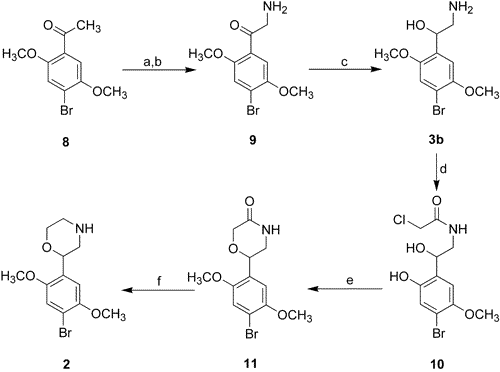(Hive Bee)
10-24-04 14:50
No 537524
(Rated as: excellent)
beta-Oxygenated Analogues of the 5-HT2A Serotonin Receptor Agonist 1-(4-Bromo-2,5-dimethoxyphenyl)-2-aminop
Richard A. Glennon, Mikhail L. Bondarev, Nantaka Khorana, Richard Young, Jesse A. May, Mark R. Hellberg, Marsha A. McLaughlin, and Najam A. Sharif
J. Med. Chem., 2004, ASAP Web Release Date: 16-Oct-2004
DOI:10.1021/jm040082s

Abstract: Activation of 5-HT2A serotonin receptors represents a novel approach to lowering intraocular pressure. Because 5-HT2A serotonin receptor agonists might also produce undesirable central effects should sufficient quantities enter the brain, attempts were made to identify 5-HT2 serotonin receptor agonists with reduced propensity to penetrate the blood-brain barrier. 1-(4- Bromo-2,5-dimethoxyphenyl)-2-aminopropan

Scheme 1 Reagents and conditions: (a) Br2/CHCl3, 5 °C to room temperature, 2 h; (b) (CH2)6N4/CHCl3, 50 °C, 1 h, then HCl/EtOH, 50 °C, 3 h; (c) NaBH4/MeOH, 0 °C; (d) ClCH2COCl/NaOH/H2O/CH2Cl2, 0 °C to room temperature, 2 h; (e) KOH/EtOH, 12 h, room temperature; (f) BH3-THF, reflux, 12 h.

Scheme 2 Reagents and conditions: (a) (COCl)2/CH2Cl2, 1-bromo-2,5-dimethoxybenzene/TiCl4, -50 C to room temperature, 60 h; (b) SiH(CH3)2Ph/TFA, -5 °C, 2 h then K2CO3, reflux, 2 h; (c) Ac2O, room temperature to 110 °C, 1 h, then 60% H2SO4, 110 °C, 1 h; (d) NaH/THF, 0 °C to room temperature 0.5 h, then MeI, reflux, 1 h.
The tendency is to push it as far as you can
(Über-Führer die Ironie)
10-24-04 17:45
No 537566
1-Hydroxy-1-(4-bromo-2,5-dimethoxyphenyl
Hydrochloride (3b).
A solution of the above 2,5-dimethoxy-4-bromo-alpha-bromoacetophenone (16.90 g, 50 mmol) and hexamethylenetetramine (7.00 g, 50 mmol) in CHCl3 (200 mL) was allowed to stir at 50 °C for 1 h. The reaction mixture was allowed to cool to the room temperature, and the white precipitate was collected by filtration and washed with CHCl3 (3 x 25 mL). The resulting quaternary salt was suspended in a mixture of 95% EtOH (50 mL) and concentrated HCl (25 mL) and heated at 50 °C for 3 h. After 15 min, the reaction mixture was homogeneous and the aminophenone hydrochloride began to crystallize. The mixture was cooled to 0 °C and the white solid was collected by filtration. The solid was recrystallized from H2O and dried in vacuo over CaCl2 to afford 10.25 g (66%) of crude product as its HCl salt, which was used without further purification.
Sodium borohydride (12.48 g, 330 mmol) was added in small portions to a stirred solution of the aminoacetophenone (10.25 g, 33 mmol) in MeOH (250 mL) at 0 °C over 1.5 h. After the addition was complete, the reaction mixture was allowed to stir at 0 °C for an additional 2 h. Solvent was evaporated under reduced pressure, H2O (150 mL) was added, and the resulting mixture was extracted with CH2Cl2 (3 x 75 mL). The combined CH2Cl2 portions were washed with H2O (3 x 50 mL) and dried (MgSO4). Solvent was evaporated under reduced pressure to give the crude free base of 3b as a yellow-white solid which was purified by recrystallization from MeOH/Et2O to give the free base of 3b as white crystals: mp 130-131 °C. The free base in MeOH (50 mL) was treated with ethereal HCl and solvent was evaporated under reduced pressure to give 8.56 g (83%) of 3b as off-white crystals following recrystallization from 2-PrOH: mp 204-207 °C
The reduction of aminoacetophenone to corresponding alcohol would prolly work w/ sodiumdithionite instead of sodiumborohydride... It is known to reduce benzylic ketones to alcohols in high yield; Post 497065 (Ganesha: "dithionite aldehyde/ketone reductions part II", Novel Discourse)
For the mild removal of the -OH; Post 504623 (Kinetic: "Another way to methaephetamine", Novel Discourse)
Overall the route is interesting becouse of Delephine. This step yields somewhat low even on primary bromoketones and it's not a very OTC route if you want to make 2C-X compounds, there is better route for that. But more importantly, someone should try to taste the aminoketone instead of reducing it, it might show some interesting activity. If so this route would bee preffered for possible "CAT Pihkality" IMO. All in all - a good post Lego!
(Hive Bee)
11-12-04 10:09
No 541263
SWIM has wondered about the activity of the non-alpha-methylated cathinone-analogue (compund #9) for quite some time.
Perhaps the beta-substitution of cathinone works likewise on PEA's, providing a smooth 2C-B analogue?
Just a thought...
Edit: NM, SWIM just found Rhodium's post about beta-Keto-PEA's - seems like he isn't the only one wondering! :)
Make Drugs - Not War!
The World needs Acid!